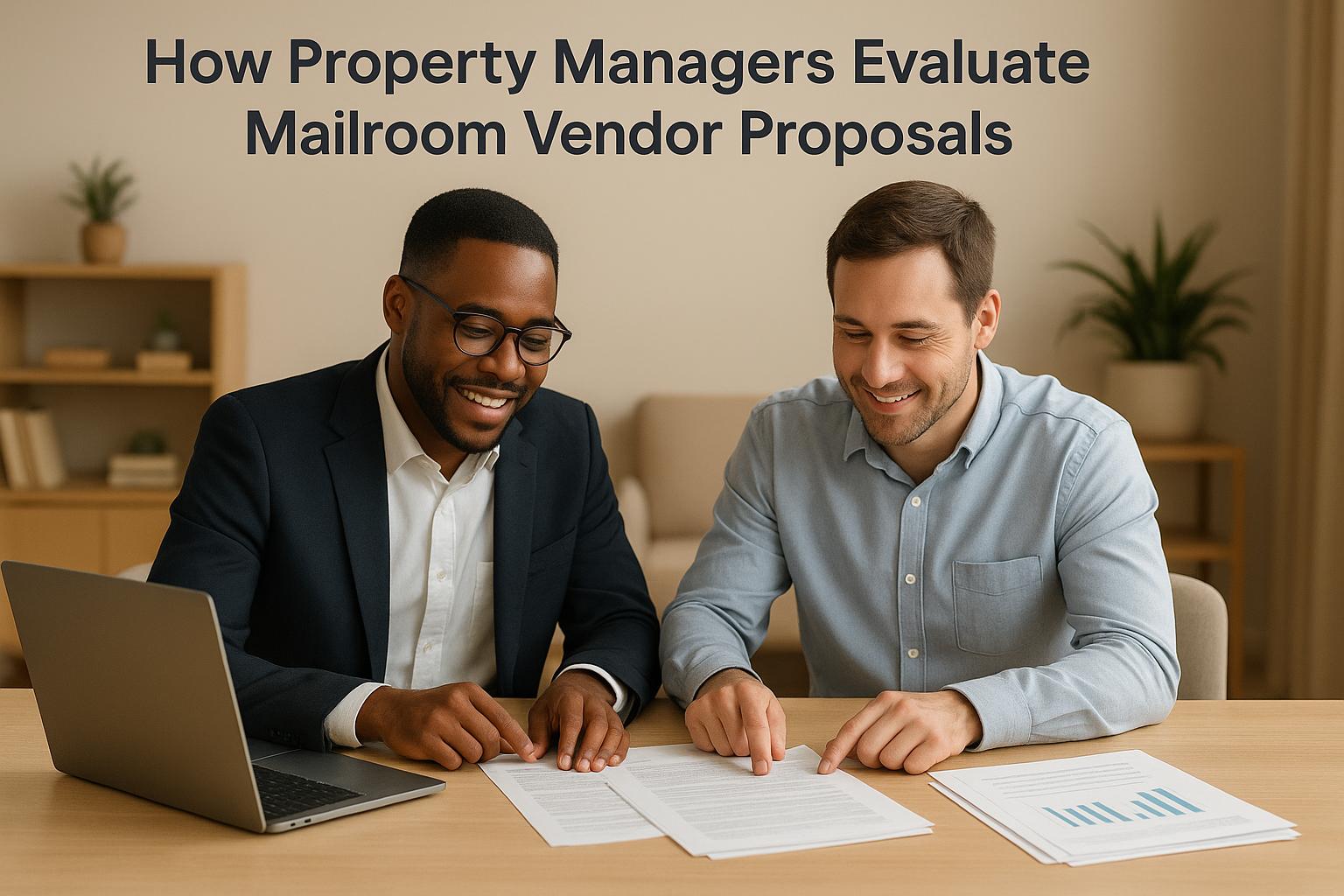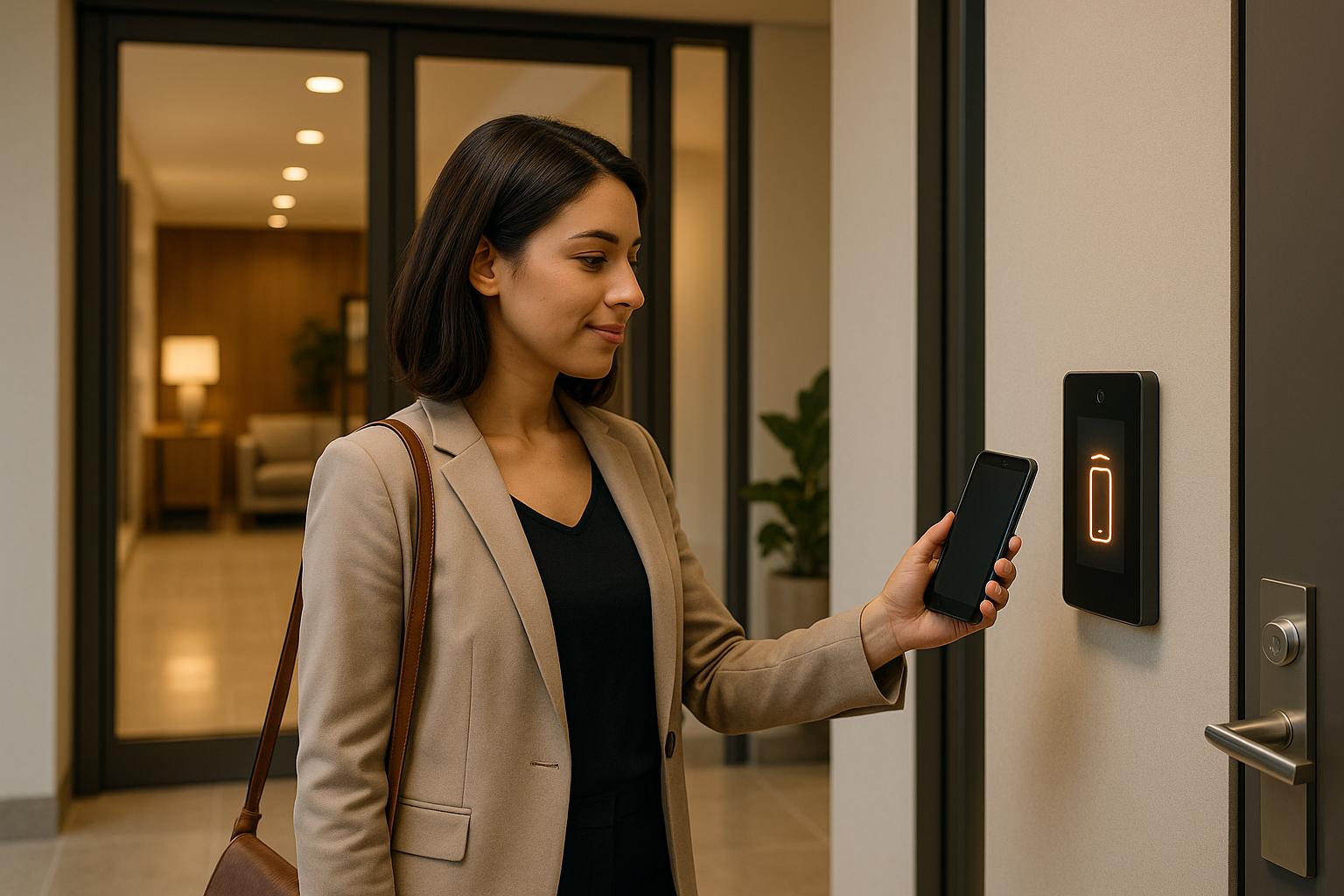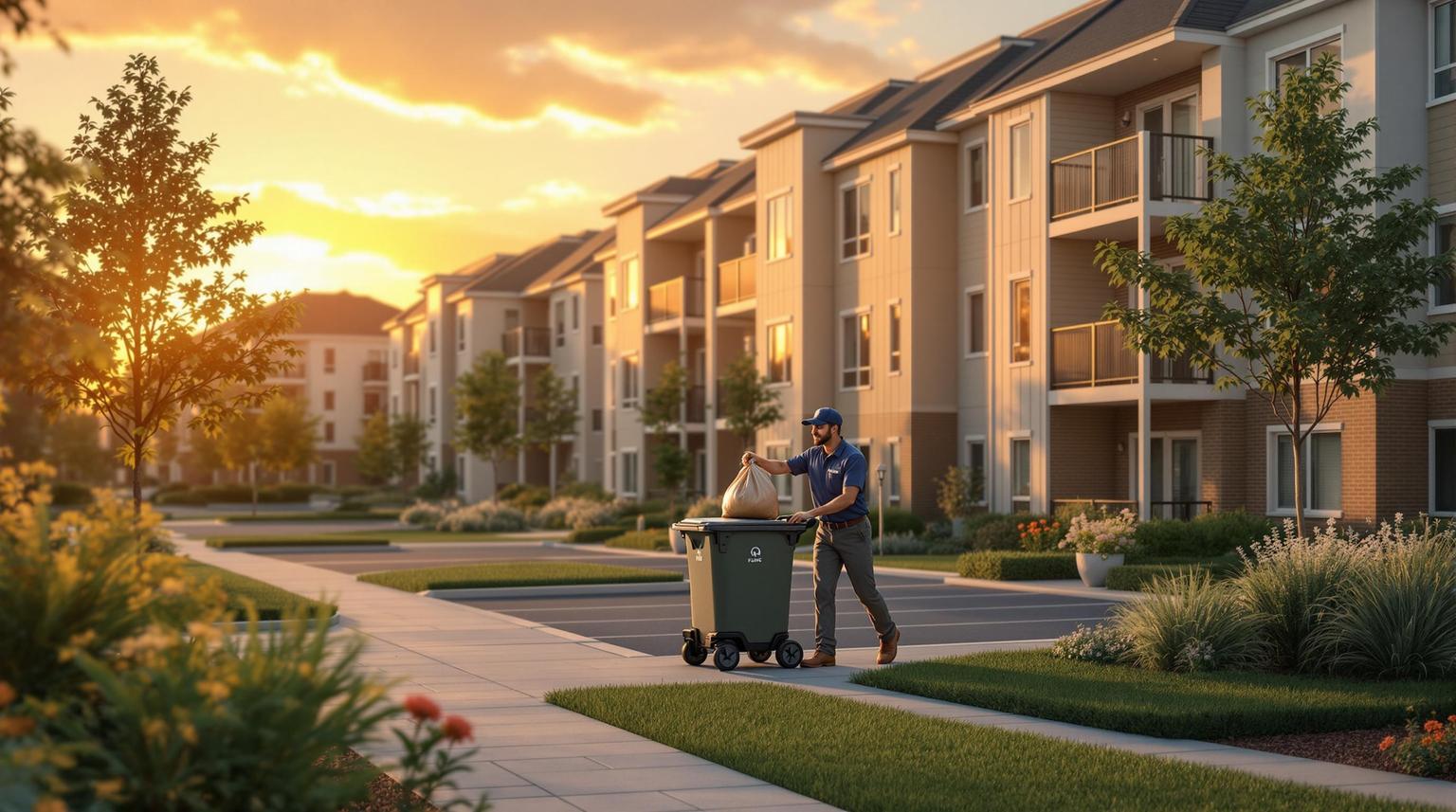Smart security systems are transforming apartment living by combining convenience, safety, and efficiency. Here's what you need to know:
- Why It Matters: With over 3,000 burglaries happening daily in the U.S., renters face higher risks. Modern systems address these concerns while meeting growing demand for smart technology - 82% of renters want at least one smart device in their homes.
- Key Features:
- Keyless Access: Digital key fobs or smartphone access streamline entry and improve security.
- AI Cameras: Detect threats in real time, reducing false alarms by up to 90%.
- License Plate Recognition (LPR): Automates vehicle access with 99% accuracy.
- Cloud-Based Management: Centralized platforms simplify monitoring, alerts, and data analysis.
- Benefits: Improved safety, lower management costs, and added convenience for residents.
These systems work together to create safer, smarter communities. From AI-powered cameras to cloud-based platforms, they’re reshaping how apartments are protected and managed.
Main Components of Apartment Smart Security Systems
Modern apartment security systems rely on four key technologies that work together to create a robust safety network. Each element plays a unique role, but they all connect seamlessly to provide a secure and efficient solution for residents and property managers.
Key Fob Access Control Systems
Key fob systems have become a cornerstone of apartment security. In fact, 75% of renters prefer digital access control systems that manage entry across shared community spaces [5]. These systems store encrypted credentials on devices like key fobs or smartphones, enabling residents to access areas with a simple tap. Property managers can use cloud-based interfaces to update permissions, track entry logs, and manage access levels with ease.
For example, residents might only have access to their floor and shared amenities, while maintenance staff can be granted entry to utility and storage areas. A property in Englewood, Colorado saw improved tenant satisfaction and security after adopting a cloud-based key fob system paired with video intercom technology.
Costs for these systems vary. Basic setups start at $500, while more advanced solutions with video intercoms range from $1,500 to $5,000 [4]. Credentials themselves are relatively affordable, with prices ranging from $5 for basic fobs to $50 for encrypted versions [4].
AI-Powered Security Cameras
AI-powered cameras are a game-changer for apartment surveillance. Unlike traditional systems, these cameras use machine learning to analyze footage in real time, identifying potential threats and unusual activities without requiring constant human oversight.
These cameras can classify objects, recognize faces, and detect hazards like smoke or breaking glass. They also reduce false alarms by up to 90%, improving overall security. For instance, an AI camera can differentiate between a resident walking through a parking garage and someone exhibiting suspicious behavior, such as loitering or entering restricted areas.
The demand for this technology reflects its growing impact. The global AI surveillance market reached $5.5 billion in 2023 and is projected to climb to $83.3 billion by 2028, growing at a rate of 9.2% annually [6].
License Plate Recognition Systems
License plate recognition (LPR) systems simplify vehicle access while offering detailed tracking capabilities for apartment communities. Using high-resolution cameras and advanced image processing, these systems achieve nearly 99% accuracy in capturing vehicle details like entry times, make, and color [7].
LPR systems automate access by recognizing registered vehicles and granting entry instantly. Property managers can also monitor traffic patterns, flag suspicious vehicles, and maintain detailed access logs. For guests, mobile apps allow for pre-registration, streamlining temporary access.
Cloud-based processing enhances these systems by enabling instant analysis of captured images, which can be monitored across multiple locations from a single dashboard. Basic LPR cameras start at $400, while more advanced systems can cost up to $50,000. However, most communities find that a camera with optical character recognition (OCR) technology averages around $1,500. These systems not only improve security but also reduce delays at entry points, creating a smoother experience for residents.
Cloud-Based Security Management Platforms
Cloud-based platforms act as the central hub for apartment security, connecting all components - like access control systems, cameras, and LPR systems - into one unified interface. Property managers can monitor real-time activity, review historical data, and respond to incidents from any internet-connected device.
One of the biggest advantages of these platforms is real-time alerts. If a camera detects unusual activity or an alarm is triggered, the system immediately notifies security teams via email, text, or mobile app. This ensures quick responses to potential threats.
These platforms also provide valuable data insights. Managers can track resident behavior patterns, monitor peak amenity usage times, and generate reports on security incidents. This information helps in making informed decisions about staffing, maintenance, and overall security upgrades.
Residents benefit from mobile integration, which lets them receive alerts, grant temporary guest access, and even monitor common areas from their phones. For larger apartment complexes, the scalability of cloud-based systems is a major plus. Adding new devices is straightforward, as most processing happens in the cloud. These platforms are also designed with compliance and data privacy in mind, ensuring that sensitive resident information remains secure.
How Security Systems Work Together
When key fob systems, AI cameras, and sensors are integrated, they create a security network that’s far more effective than individual components working on their own. By combining these technologies, modern security systems ensure seamless protection across properties.
Connecting Access Control, Cameras, and Sensors
Today’s apartment complexes achieve robust security by linking access control systems, surveillance cameras, and environmental sensors through a central cloud-based platform. This integration allows all components to work as a unified system.
For example, when a resident uses their key fob, the access control system springs into action. Nearby AI cameras activate, the entry is logged, and the system verifies the resident's identity. If an unauthorized attempt occurs, the system immediately alerts security personnel.
License plate recognition systems further enhance security. Registered vehicles automatically trigger gate openings and are visually logged, while unregistered vehicles prompt real-time alerts, complete with images and license plate details.
Environmental sensors add another layer of safety by monitoring for hazards like smoke, carbon monoxide, water leaks, or abnormal temperature changes. When these sensors detect an issue, they record the location and activate emergency protocols without delay.
"Integrating access control with our technology lets us offer a truly holistic solution that strengthens both security and the Sugar app experience for our customers." - Fatima Dicko, CEO at Sugar [8]
This integration also allows for visual verification. Property managers can monitor who enters the building - or even specific units - through synchronized camera feeds triggered by access events. This capability not only deters unauthorized access but also provides critical evidence during security incidents. In emergencies, the system’s interconnected nature ensures swift, automated responses.
Automated Alerts and Emergency Response
Smart security systems shine in emergencies by using automated alerts to cut response times dramatically. AI-powered cameras constantly analyze video feeds, identifying potential threats like weapons, medical emergencies, physical altercations, or unauthorized access. Once a threat is detected, the system reacts instantly - locking doors, activating emergency lighting, and notifying security teams and law enforcement.
Emergency communication systems ensure that residents and staff receive alerts promptly, no matter their location or device. For instance, Southeastern Security Professionals noted in January 2025 how these systems are crucial for timely communication during fires, severe weather, gas leaks, or security breaches in multi-family housing. This not only boosts resident safety but also helps meet regulatory requirements [9].
Cloud-based platforms further enhance emergency response by offering scalability and redundancy. Even if local systems go offline, the cloud ensures that alerts and safety protocols remain operational. With these rapid-response capabilities in place, AI is now shifting its focus toward anticipating and preventing issues before they arise.
Using AI to Predict and Prevent Security Issues
AI takes security to the next level by moving from reactive measures to proactive prevention. By analyzing data from cameras, sensors, and access control systems, AI can identify unusual patterns and predict potential threats. For instance, it can detect behaviors like loitering in parking areas or attempts to access restricted zones by learning what constitutes normal activity for specific times and locations.
AI’s predictive power doesn’t stop at individual actions - it can also analyze crowd behavior to identify risks early. Additionally, it helps prevent equipment failures and safety hazards by monitoring data from fire detection systems and access control hardware, enabling timely maintenance to address vulnerabilities.
"AI is a tool, and it allows emergency managers to focus in on what they want to focus in on. They've got to get the right information out at the right time to the right people. Let the system do the work, and that's what AI does. That's the art of artificial intelligence." - Marc Jaromin, director of public safety platforms at Futuri [12]
Adoption of AI-driven security is growing rapidly. A staggering 97% of executives believe AI will reshape community safety, and half of all agencies are prioritizing investments in AI-driven public safety solutions [10]. AI also addresses a critical limitation of human monitoring: after just 20 minutes of watching video feeds, people lose 95% of their ability to detect key events [11]. By filling this gap, AI becomes an essential partner for security teams, ensuring no detail goes unnoticed.
sbb-itb-58157f8
Benefits for Property Managers and Residents
Smart security systems do more than just protect - they simplify property management and improve the overall experience for residents.
Better Safety and Security for Residents
In the U.S., a burglary happens roughly every 30 seconds [13], making solid security measures a must. Interestingly, 54% of tenants say they'd pay higher rent for better security [13]. Smart security systems, with their layered technology, provide multiple levels of protection, helping to address common vulnerabilities like those in ground-floor apartments. This not only enhances tenant safety but also boosts satisfaction and retention rates [13].
Easier Property Management Operations
Smart systems don't just keep residents safe - they also make property management much smoother. For example, these systems automate tasks that used to be time-consuming. Instead of dealing with lost keys, issuing new ones, or changing locks when tenants move out, property managers can rely on automated access solutions. This reduces hassle and lowers staffing costs [2].
Cloud-based access systems allow managers to control doors and gates remotely, while real-time monitoring helps detect equipment issues early. With the ability to address minor problems remotely, managers can prevent them from turning into costly repairs. This operational efficiency not only saves time but also ensures a better experience for residents.
More Convenience for Residents
Smart systems also bring a new level of convenience for residents. Mobile access controls let tenants unlock doors with their smartphones or create temporary codes for guests.
Take the Oxford Vista apartment complex, for example. Residents there can use a video intercom integrated with the ProdataKey system to visually confirm visitors at their door. This adds both security and convenience [3].
Demand for smart technology is growing rapidly. According to the 2024 NMHC & Grace Hill Renter Preferences Survey, 67% of renters are interested in keyless smart locks, 72% want smart thermostats, 69% are drawn to smart leak-detection sensors, and a whopping 82% want at least one smart device in their home [1].
"Smart locks are really important right now. Especially in Class A properties, if all you have is a keyed lock, you're already behind the times. It's a differentiator that's convenient for residents and convenient for us. If there's ever an issue or change, we can take care of it remotely and quickly to keep residents happy." - Marcie Williams, President, RKW Residential [14]
Real-time notifications keep residents informed about building access and activity, offering transparency and peace of mind. Plus, a centralized control platform allows residents to manage everything - from door locks to environmental settings - through a single app on their smartphone. This streamlined control not only simplifies daily life but also makes resolving maintenance or access issues much easier, ensuring happier residents overall.
The Future of Apartment Security Systems
Smart security systems have reshaped how apartments are protected and managed, with the global smart home security market expected to surpass $90 billion by 2028 [16]. These advancements are not just about safety - they’re transforming how communities operate.
Mike Branam highlights a key innovation: "AI deterrence (AID), the latest perimeter video technology, leverages AI to proactively deter unwanted behavior through automated warnings, automating most security tasks without human intervention" [17]. This proactive approach addresses issues before they escalate.
Biometric systems are also stepping up the game, incorporating voice, facial, and fingerprint recognition for added verification. Meanwhile, advanced sensors - such as those for vape detection, air quality, carbon monoxide, water leaks, and temperature - enable real-time monitoring and smarter decision-making [15][16].
Touchless access control and mobile credentials are quickly becoming the norm. They provide convenience, improve hygiene, and eliminate risks associated with lost keys or cards. On top of that, property managers can now use occupancy data to optimize resources and fine-tune existing systems [15]. These innovations are setting the stage for security solutions that are both efficient and forward-thinking.
Sustainability is another driving force behind these changes. Securitas Technology has committed to reducing greenhouse gas emissions by 42% by 2030, noting that 70% of emissions in electronic security come from product use [19]. John Tomin emphasizes this focus: "We focus on providing energy-efficient solutions and services for the long term, creating the future of sustainable security" [20].
Even with all these technological advancements, the tenant experience remains the top priority. Merrick Lackner, CEO of Rently, underscores this shift: "We're witnessing a real shift in what renters consider essential. Smart home technology is no longer a nice-to-have. It's a baseline expectation. This isn't just about gadgets; it's about giving renters more control, security, and comfort in their day-to-day lives. Property managers who move now can turn this shift into a true competitive edge" [18].
Smart home technology now plays a bigger role in how renters perceive safety compared to traditional factors. For apartment communities ready to embrace these changes, the payoff could be a stronger edge in attracting and retaining residents [18].
FAQs
How do smart security systems make apartment living safer and more convenient for residents?
Smart security systems bring both safety and convenience to apartment communities by introducing modern features like remote access control. With this technology, residents can use their mobile devices to manage who enters their homes, whether they’re on the couch or miles away. Need to let a friend in while you're at work? No problem. Want to double-check that the door is locked? Just tap your phone.
These systems go beyond access control. Real-time surveillance and AI-driven cameras keep an eye on activity, helping to prevent unauthorized access and providing a sense of security for residents. For both tenants and property managers, tools like key fob systems and cloud-based monitoring simplify daily routines. No more worrying about misplaced keys or complicated entry procedures - smart solutions make life easier while keeping everyone safer.
What factors affect the cost of installing smart security systems in apartment communities?
The cost of setting up smart security systems in apartment communities can differ based on various factors. Basic equipment typically costs between $160 and $270, with monthly monitoring fees ranging from $20 to $50. On top of that, installation expenses can range from $100 to $800, depending on how complex the system is and the features it includes.
If you’re considering advanced options like AI-powered cameras or license plate readers, be prepared for additional costs. These technologies often require professional installation and regular maintenance, which can increase the overall investment. To get a clearer picture of the costs, it's important to evaluate the specific needs and scale of the property.
How do AI-powered cameras and license plate recognition systems enhance security in modern apartment communities?
AI-powered cameras and license plate recognition (LPR) systems combine cutting-edge technology to enhance security by analyzing video footage in real time. These cameras can pinpoint vehicles and read license plates with precision, even under tough conditions like dim lighting or high-speed movement.
The license plate data is securely stored on a cloud platform, enabling automated access control, instant alerts for suspicious or unauthorized vehicles, and comprehensive records for later use. This system minimizes the need for manual monitoring, boosting efficiency while creating a safer environment for both residents and visitors in today’s apartment communities.


